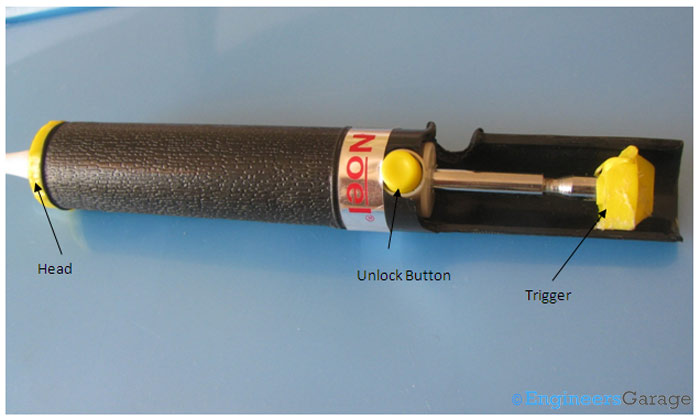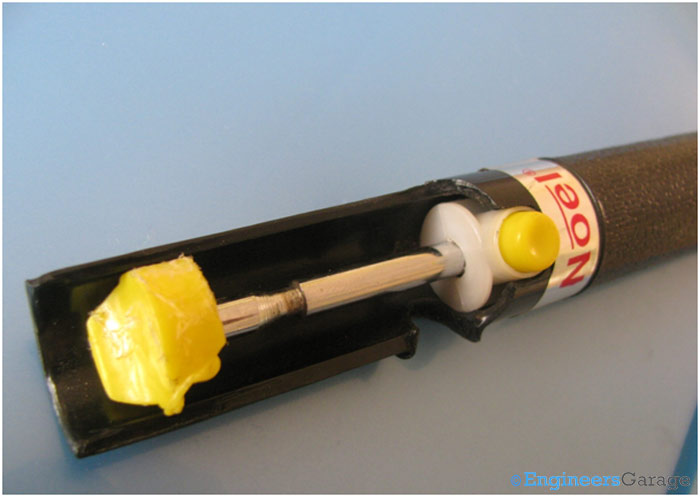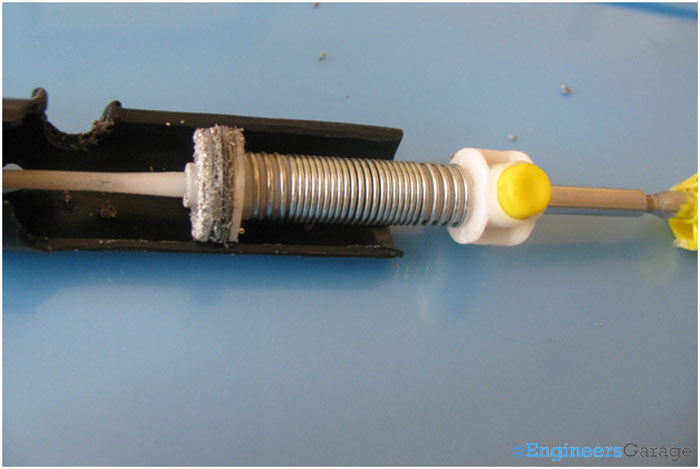DESOLDERING is the process of removing soldered components from a circuit made on PCB. Desoldering pump along with the soldering iron is used for this purpose. A desoldering pump also known as solder sucker is a small mechanical device which sucks the liquid/molten solder from the joint where the components are mounted. In order to desolder a component from the PCB, we first heat up the solder joint with the soldering iron till the solder liquefies/melts. At the same moment we actuate the soldering pump by pressing the trigger lever and bring the tip over the molten metal and pull the trigger back by pressing a button shown in the below image. At this instant the lever is pulled back and the tip of the pump sucks the molten solder. This process is repeated until all the residue solder is sucked by the pump and the hole on the PCB is clear to solder a fresh component.

Fig. 1: Desoldering Pump and its Parts
Above image shows a desoldering pump – head, trigger and button of the soldering pump are marked. To actuate the pump the lever is pressed until there is a click sound which indicates that the lever will remain locked in the same position.

Fig. 2: Mechanical Arrangement of Pump Head

Fig. 3: Design of Pump Head
The desoldering pump’s bottom head contains a hole through which the molten solder is sucked when the pump is triggered. The head is designed such that the extracted solder does not solidify and block it, consequently the sucked metal can be removed and discarded easily.
Internal Structure

Fig. 4: Internal Structure of Pump
Removing the outer case reveals its major components – spring, spring lever, a mechanical lock and a piston to draw the solder.

Fig. 5: Image showing Structure of Desoldering Head
The desoldering head has the structure and working similar to a syringe. The piston draws the molten solder when it is pulled back by the spring.
Working

Fig. 6: Spring and Lock Arrangement
When desoldering pump is operated, the spring gets compressed as shown in the above image. At this moment if the button is pressed the mechanical lock will be opened and spring will extend back to the normal position pulling the piston towards the lever.

Fig. 7: Images showing working of Mechanical Lock
Working of the mechanical lock is shown in the image. If the lever is pressed a special shaped edging on the lever is wedged with mechanical lock. As we press the yellow button the lock will be slightly moved away clearing the way for lever to move back. Another small spring is used to keep the lock in a fixed position.

Fig. 8: Close View of Mechanical Lock
The mechanical lock is more clearly shown in the above image.
Structure of Piston

Fig. 9: Image Showing Structure of Piston
Structure of the piston is shown in the image. When pump is triggered, the piston creates a vacuum in the front desoldering head and allows entering the air only from the hole on the tip. As the piston moves speedily, the sudden vacuum draws the air next to the tip and with the air the molten solder is also drawn. The sucked solder is discarded by pressing the lever. The same process is practiced few times to remove the old solder completely.
Filed Under: Insight


Questions related to this article?
👉Ask and discuss on EDAboard.com and Electro-Tech-Online.com forums.
Tell Us What You Think!!
You must be logged in to post a comment.